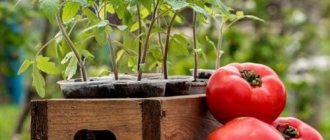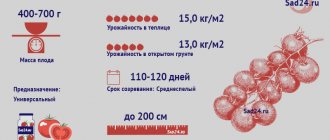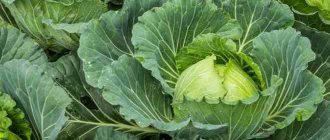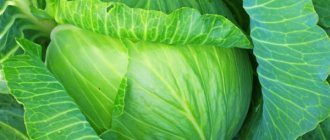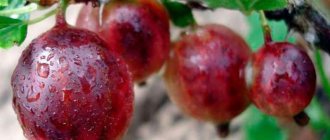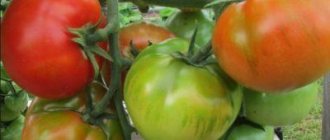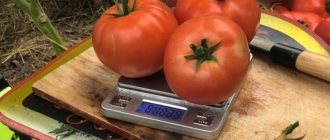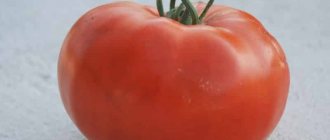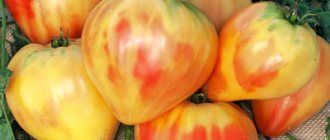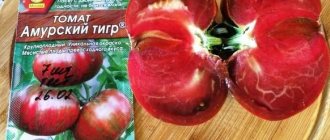Brief information about the variety
- Fruits and bush : red tomatoes. Average weight – 450 g, it is possible to grow a fruit weighing up to 2 kg; the bush is indeterminate, reaches 180 cm.
- Productivity : 4-4.5 kg per bush.
- Resistance : good immunity to tobacco mosaic, cladosporiosis and fusarium.
- Distribution : all regions, it is necessary to grow in protected soil conditions; in the northern regions, provide additional heating for the greenhouse.
- Application : the fruits are suitable for salads, canning in slices, freezing, as well as for processing into ketchups and pastes.
- Planting : use the seedling method. The procedure is carried out at the end of May according to a 50x70 cm pattern, with a frequency of no more than 3 plants per meter.
- Soil : you need to choose light and turf.
- Care : fertilizing and watering - once every 12-15 days, pinching - mandatory, formation into 1 and 2 stems.
- Ripening period : the crop ripens in early August, bears fruit until the end of October.
Description of the variety
This tomato is chosen mainly by experienced gardeners. The reason is that the tomato is quite finicky to grow. Therefore, in order to collect a decent harvest of large fruits, you need to work hard.
The characteristics and description of the variety indicate that the Russian size is late. From the moment of sowing the seeds for seedlings until the first ripe tomato is obtained, at least 125 days pass. This is a month longer than some of the early hybrids available to Russian gardeners. Nevertheless, for the sake of an excellent harvest, many are willing to wait.
The Russian size tomato has additional advantages. The harvest can be harvested quite late. Most often this happens in August. But fruiting should be very long. Sometimes the bushes produce new tomatoes for 3 months, so you can enjoy delicious tomatoes until October. Most often, active fruiting ends only with the onset of cold weather. If the tomato is grown in the southern territory, then the fruits can be harvested even until November.
The difficulty in caring for tomatoes of this variety lies in the fact that it is an indeterminate type hybrid. Bushes can grow to very large sizes. The average height of a plant when grown in open ground will be 180 cm. Therefore, the bushes must be tied to a strong support. Otherwise, the plant will fall to the ground, and when it comes into contact with the soil, the fruits will quickly deteriorate, which will negatively affect the yield.
Russian size tomato bushes are not only tall, but also branched. It is advisable to remove excess branches immediately, since they take away the energy from the plant that could be spent on the formation of fruits. If you don’t do pinching, there won’t be any large tomatoes on the bushes.
Experts recommend leaving only 2 main stems. This will be enough to produce a lot of tasty and large tomatoes. Tomatoes appear in clusters, which should preferably be tied to the main stem so that they do not break off due to being too heavy.
Considering that the bushes of the Russian size variety turn out to be spreading even when formed and pinched, too dense planting for this hybrid is not recommended. It is best to place no more than 4 plants per 1 m² of fertilized soil. This way the branches and leaves will not block the sun’s rays, which are necessary for the normal development of the fruit.
For a Russian size tomato, such aspects as high-quality watering, saturation of the roots with oxygen by loosening, and weeding are important. Next to weeds, the bush will not produce large fruits. You can also increase productivity with the help of fertilizers. Tomato loves both mineral and organic fertilizers. With proper agricultural technology, you can collect up to 10 kg of fruit from each bush. Even under not the most favorable conditions, gardeners receive 7-8 kg of tasty tomatoes.
general characteristics
The supergiant tomato Russian size is a late-ripening hybrid with an extended fruiting period; the first tomatoes ripen 125-127 days after emergence.
Description of fruits and bush
The fruits are large, flat-round and slightly ribbed, weighing from 300 g to 2 kg, juicy and fleshy with a strong and smooth skin.
The color of unripe tomatoes is light green, ripe tomatoes are bright red. The bush is of indeterminate type, reaches 180 cm in height, branches and has a strong stem. 3 tomatoes are formed on the fruit cluster.
Productivity
The variety is characterized by high yield: from 1 sq. m can be harvested up to 8 kg, taking into account the planting of 2 plants on it. Fruits from August until frost.
Disease resistance
Tomato Russian size F1 is immune to many diseases, but is sensitive to temperature changes and lack of nutrients in the soil.
Resistance to:
- tobacco mosaic virus;
- cladosporiosis;
- fusarium.
Due to the late ripening of the crop, it is susceptible to late blight, so preventive measures are required.
Application of fruits
Large and juicy tomatoes are good for making salads and vegetable slices, juice and tomato paste.
Due to their large size, it is inconvenient to preserve them whole, but the slices in the marinade keep their shape perfectly. They go well with other vegetables and are suitable for assorted dishes and adjika.
Growing regions
The variety is recommended to be grown in greenhouses
The variety is suitable for greenhouse cultivation throughout Russia.
In the northern regions (Arkhangelsk, Murmansk, the Republic of Karelia and Komi, Novgorod and other regions) it is better to use heated greenhouses.
Review of tomato variety F1: characteristics and yield
What are these tomato varieties with the ending F1? In this way, hybrid tomatoes specially bred by breeders by crossing other varieties are marked. Scientists have worked hard to ensure that newly created plants have the best qualities of their ancestors. As a rule, hybrids have good characteristics - they are resistant to many diseases, are not afraid of cold weather, and are undemanding to soil fertility.
Features of hybrid tomatoes
F1 varieties can belong to a low-growing species, a tall one, and may have different ripening periods. The characteristic indicates the different size, color and weight of the fruit. For sale to summer residents they offer a wide variety of hybrids, for every taste and for any purpose - these are red and orange tomatoes, small and large, for pickling and for fresh consumption. Characteristics and descriptions of F1 tomato varieties indicate the properties of a particular variety.
Breeders note that the greater the difference in characteristics between the tomato varieties being crossed, the stronger the hybrid can be obtained.
The main advantages of hybrid varieties are as follows:
- resistance to common vegetable diseases and pests;
- undemanding to the growing soil;
- early fruit ripening;
- increased productivity.
Hybrid varieties may be somewhat inferior to pure tomatoes in terms of fruit taste, but this drawback is not too noticeable.
Which hybrid varieties to choose?
In the conditions of central Russia, it is better to grow tomatoes in a greenhouse. The following hybrid varieties are recommended for cultivation:
- VerliokaF This is a tall early variety. Its fruits are suitable for use in culinary dishes and for winter preparations. The fruits have a classic round shape, bright red color, and weigh up to 100 grams. The characteristic also notes the disadvantage of the variety - the demands of tomatoes on the composition of the soil and the need to periodically feed the plants with fertilizers. In cool weather, warm the water until warm before watering.
Search companies have known F1 varieties for a long time. She successfully sells hybrid seeds in specialized stores and large supermarkets. Characteristics and descriptions of F1 tomato varieties can be found on the package with seeds. The photo shows fruiting bushes of hybrid tomatoes. In reviews, experienced gardeners advise which varieties of tomatoes are best to plant in certain climatic conditions.
Advantages and disadvantages
To get a good harvest, you need to take into account the characteristics of the variety. It is relatively unpretentious in terms of feeding and care, but is sensitive to violations of processing technology and care, so experienced gardeners will have the best results.
The following advantages can be highlighted:
- high productivity;
- excellent taste characteristics of the fruit, keeping quality and long shelf life;
- long fruiting period;
- high resistance to diseases;
- traditional care.
The disadvantages include:
- the need for fixation and formation of the bush;
- susceptibility to phytosporosis;
- relatively frequent feeding;
- the need for large space in the beds;
- the need for additional heating of the greenhouse when growing in the northern regions.
Cio-chio-san
The only disadvantage of this indeterminate (sometimes growing up to 2 m) tomato is the need for support and shaping of the bush. The rest is a set of advantages! It is resistant to unfavorable conditions and can grow even in Siberia and the Far East. It bears fruit well not only in the greenhouse, but also in open ground. It is not afraid of the main nightshade diseases.
“In the greenhouse, I am always pleased with the Chio-chio-san variety from Gavrish. Maria Dolzhikova.
In terms of ripening time, the tomato belongs to the mid-early category - 100-120 days pass from the appearance of the first shoots to the start of fruiting. It won’t let you down with the harvest either - although the tomatoes are small (about 30-40 g on average), they ripen up to 50 pcs. on the brushes! So the yield from a bush with proper care is 4 kg and can reach a record 6 kg. And the taste of this tomato is excellent! And in the blanks it looks very presentable.
“Chio-chio-san - sweet, very productive, tall, with up to 50 smooth, thin-skinned sweet tomatoes in a bunch! Universal for both food and preservation.” Tatyana Vznuzdaeva. Tula region
Growing seedlings
Sowing of seedlings is carried out in early April. The seeds are pre-treated with any stimulant.
The soil is suitable light, with neutral acidity. You can prepare the soil yourself, but you should definitely disinfect it by calcining it in the oven or leaving it in the freezer for a day.
Freezing the soil does not disinfect it. Spores of fungi, infectious agents and bacteria easily tolerate temperatures down to -104 to -128 degrees.
Recommended soil mixture composition for seedlings: turf, compost, peat and river sand (2:1:1:1).
The seeds are deepened by 1 cm, they are laid out at a distance of 1.5-2 cm from each other and 3-4 cm between the rows.
The crops are covered with film until the first shoots appear. The optimal temperature for growing seedlings during the day is 23-25 °, at night at least 18 °.
With the appearance of two true leaves, after about 15-18 days, the seedlings need to be replanted. For picking, it is convenient to use peat pots, which are then placed in the soil in the greenhouse.
Thus, the root system will remain as intact as possible. A week before planting in the greenhouse, the plants are gradually hardened off; the day before planting, the seedlings are left in the fresh air for the whole day.
Tomatoes very easily tolerate replanting both when picked and to a permanent place in the ground. Do not neglect the picking procedure, because... this will help the seedlings form a more developed root system.
Planting seedlings in the ground
60-65 days after sowing, the seedlings are ready for planting in the greenhouse. They are rarely planted - 2 bushes per square meter. m, when growing in one stem, 3 are allowed.
After a few days, the plants need to be tied up for the first time and then systematically fixed as they grow. To obtain large fruits, the bush is grown in one stem, for medium ones - in 2.
Optimal conditions and planting technology
The care and cultivation of the described tomato variety is practically no different from the agricultural technology of other varieties. Tomatoes prefer well-lit areas, with temperatures of +21...+23°C during the day and not lower than +16°C at night. As for humidity, it is recommended to maintain a slightly above average level in the greenhouse - 80-85%.
Immediately before sowing, you should carefully prepare the seeds:
- the grains are dipped for several hours in a container with a weak saline solution: the seeds that sink to the bottom of the container are selected for planting;
- the selected seed material is treated with any store-bought growth stimulant or soaked in a solution of aloe or honey.
As a soil mixture for tomatoes, you should use light, nutritious soil with a neutral acidity level.
You can prepare the soil mixture yourself using:
- turf soil - 2 parts;
- compost - 1 part;
- peat - 1 part;
- dry river sand - 1 part.
Self-made soil must be disinfected (by any method of your choice):
- calcine the soil for 25–30 minutes in the oven at a temperature of +180°C;
- spill the soil with a weak solution of potassium permanganate, dry well;
- freeze in the freezer for a day.
After all the preparatory measures have been carried out, it is necessary to sow the seeds:
- Soil is poured into prepared containers, which can be disposable plastic cups, peat cassettes, or plastic boxes.
- Make depressions up to 1 cm in the soil and place one seed at a time. In this case, the distance between planting grains should be at least 1.5–2.5 cm, between rows - 3–4 cm.
- The seeds are sprinkled with soil and the surface is irrigated with a spray bottle.
- The planting is covered with plastic film.
The container with future seedlings must be placed in a well-lit, warm place, with stable daytime temperatures of +23...+25°C during the day and not lower than +18°C at night. Crops should be given 12 hours of daylight. If there is a lack of light, it is recommended to use phytolamps.
Features of care
Plants need to be cared for correctly
Caring for Russian size tomatoes is simple, but should be permanent, so it should not be chosen by gardeners who rarely appear on the site.
Main events:
- hilling and loosening the earth;
- systematic pinching, leaves break off when the first inflorescence appears, and then throughout the growing season;
- leading into one or two stems;
- garter as the bush grows (every 30 cm);
- careful use of nitrogen fertilizers, an excess will lead to excess leaf growth and the fruits will be small;
- fertilizing with phosphorus and potassium fertilizers 2-3 times during the growing period;
- prevention from pests and diseases;
- abundant watering, at least 2-3 times a week, insignificant watering will lead to the development of lateral roots, and this is not enough to nourish the plant.
When the bush reaches the height of the greenhouse ceiling, the top should be pinched.
The hybrid is responsive to soil changes and a lack of nutrients can be determined by its appearance. By recognizing the first signs, you can eliminate the problem in time.
Signs of malnutrition
- Small leaves with red-blue veins and a yellowed stem indicate a lack of nitrogen; the fruits become small and hard;
- Curling of leaves inward indicates phosphorus deficiency;
- Marginal leaf burn – low potassium;
- The appearance of yellow spots on young leaves indicates a lack of calcium; the top of the bush may begin to rot at high humidity;
- Brown spots on tomatoes and stems indicate a lack of boron;
- Chlorosis and yellowing of leaves with upward curling are signs of molybdenum deficiency;
- Chlorosis of young leaves and stunted growth are due to iron deficiency.
If the goal of growing a variety is to obtain the largest possible fruits, it is necessary to grow the plant in one stem and leave one ovary on the clusters.
Tomato Spring
Mid-season, indeterminate, large-fruited tomato hybrid of Altai selection. Designed for cultivation in greenhouses and open ground.
The bush is medium-sized, the leaves are large, green. The inflorescence is simple. The manufacturer recommends forming the plant into 1-2 stems. A garter to the support is required.
Basic qualities of fruits
The fruits are round, slightly ribbed, dense, even, red in color at maturity, weighing 180-250 grams, excellent (for a hybrid) taste. These tomatoes are intended for fresh consumption and homemade preparations.
Productivity: under film covers up to 7 kg per plant (with proper agricultural technology, watering and fertilizing).
Features of growing tomato Spring, planting and care
The seeds of this tomato are sown for seedlings 60-65 days before the plants are supposed to be planted in a permanent place. When planting seedlings in the ground for 1 sq. 3-4 plants are placed per meter of plot. The variety responds well to watering and fertilizing with complex mineral fertilizers.
Originator: Dederko V.N.
If you grew Vesna tomatoes, please write whether you liked them or not. What was the yield and taste of the fruits like under your climatic conditions? Will you grow them again? Briefly describe the advantages and disadvantages of this tomato in your opinion. If possible, attach a photo of the entire bush or individual fruits you grew to your comment. Thank you!
Your reviews of the Vesna tomato and additions to the description will help many gardeners evaluate this variety more objectively and decide whether it is worth planting or not.
Disease and pest control
The variety is immune to many diseases, but cases of late blight are common. For prevention, frequent loosening and hilling of the soil and treatment with special means (Quadris, Fitosporin) are recommended.
Bushes are most often affected by wireworms, mole crickets, whiteflies and nematodes. To destroy and prevent parasites, the drugs Quadris and Fitosporin are used, and can also be treated with a soap solution and potassium permanganate.
Quadris and phytosporin are fungicides, they are used to combat fungal plant diseases. To protect against pests they are useless; insecticides must be used.
Tomatoes with yellow fruits, varieties, characteristics
Yellow tomatoes are rarely grown because they can only be eaten fresh, but they are not suitable for preparations, making tomato paste or sauces. They are also not used for canning in jars; although the result is a normal, tasty pickled tomato, it is not the traditional red color.
But in the salad, the combination of red tomatoes, yellow tomatoes and green cucumbers looks very appetizing. Also, some people are allergic to red tomatoes, so they can only eat yellow ones.
There are currently quite a lot of varieties of tomatoes with yellow fruits, especially foreign selection, mainly from Holland. There are interesting varieties of bush yellow tomatoes, which, for the sake of exoticism, can be grown in boxes and in hanging pots if the garden is small. This is a variety of yellow tomatoes with small fruits and drooping tops, “Pendulina Orange” and “Ida Gold”. By the way, when hanging, tomatoes are almost not affected by viral and fungal diseases, due to the lack of contact with the soil and good ventilation.
Yellow pear-shaped tomatoes will delight exotic lovers if you plant the “Yellow Pearshaped” variety. But among the old varieties with yellow tomatoes that bear fruit in clusters and are characterized by friendly ripening, you can choose the “Golden Konigin” variety.
Yes, the varieties differ in size and taste, they are large and just like cherry tomatoes, but we will describe only the two most common, old varieties that have been in our gardens for a long time. These are yellow tomatoes “Ruslan” and “Khurma”.
Yellow tomato variety “Persimmon”, characteristics
Refers to mid-season tomato varieties. The tomato is suitable for growing in open ground and under film cover; it grows well throughout the country. The “Persimmon” tomato as a plant belongs to the determinant type, which means it is not a very tall bush and will not produce too many side shoots and stepsons. Which makes taking care of him much easier.
Although the bush can grow up to 90-100cm, so for insurance you can immediately put up pegs when planting seedlings. Usually not many yellow tomatoes are grown, so tying up their bushes won’t be too difficult. The inflorescences of the “Persimmon” tomato variety are collected 3-4 in a cluster.
A distinctive feature of the variety is the size of the tomato. The fruits are large, weighing from 100 to 300g, the color is bright yellow or orange. Tomatoes with thick skin, juicy, sweet. The yield may not be high, up to 2.5-3 kg per bush, but fruiting is long-lasting, until late autumn.
The first fruits can be harvested 105-110 days after the seeds germinate. It is better to grow seedlings. Sow in March in boxes or cups with coconut tablets. Again, I would like to remind you that there are not many tomatoes of this variety grown in the garden, so it is quite possible to grow seedlings in cups. This will allow you to obtain strong seedlings, and at the age of 60 days they will be planted in open ground. Strong seedlings planted from separate cups will not be injured by the roots and will begin to grow faster.
After all, the “Persimmon” tomato variety is not endowed with special disease resistance, so you will have to monitor ventilation and humidity. High and constant humidity stimulates the development of viral and fungal diseases of tomatoes.
Yellow tomato variety "Ruslan", description
“Ruslan” is a variety of yellow tomatoes recommended for growing in areas with a warm climate; it is endowed with special resistance to heat and therefore tolerates short-term drying out of the soil. The variety is mid-season, indeterminate type, and therefore tall. Tall varieties of tomatoes are usually recommended for growing in greenhouses and greenhouses. BUT if it is possible to provide a tall yellow tomato bush with support, then it can be successfully grown in open ground. Due to its tall growth, the yield of the “Ruslan” variety will be up to 10 kg of fruits per 1 sq. meters.
The peculiarity of growing tall tomatoes is constant care for the formation of a bush. It is necessary to constantly remove the shoots and pinch them so that the bush does not turn into a lush plant with a chaotic arrangement of shoots and a lack of fruits.
Tomato fruits are large, up to 300g, yellow in color, round in shape, excellent taste, with sweet pulp and a small amount of seeds.
The “Ruslan” variety is mid-season; the first fruits can be picked 110 days after germination. But it is better to grow this variety through seedlings. Typically, tall tomatoes are sown for seedlings before February 20th. For this, they use the best nutritious soil, consisting of 1 part peat and 1 part turfy loamy soil. Moisten the soil and bury the prepared seeds 1-2cm. Sprinkle with soil and cover with film; as soon as the seedlings appear, remove the film and keep the seedlings in a warm, bright place.
Errors during cultivation
If you follow the recommendations and proper care, Russian Size tomatoes easily gain the good mass stated in the description.
The most common mistake is not watering the plant enough. Gardeners are afraid of provoking an excess of moisture and associated rotting and fungal damage.
However, less abundant but frequent watering leads to underdevelopment of the deep roots of the plant, as a result of which the fruits become smaller.
To avoid this, the amount of water should be 10-12 liters per bush. In addition, you need to tie up not only the stem, but also the clusters with large fruits, so that they do not break off due to weight.
Farmers' reviews of tomato Russian size
The Russian size has positive reviews from gardeners. Despite all the difficulties of growing it, gardeners are pleased with the result.
Ksenia Ivanova, Moscow “Russian size is my favorite hybrid. Every year I plant it in a greenhouse. Yes, you need to take care of it regularly, but it's worth it. Its fruits have a rich, sweet taste. The largest tomato I managed to grow weighed 1.4 kg.”
Alena Krikunova, Sochi “I’ve been planting Russian size for three years now. I really like its huge fruits. They turn out exactly like in the photo. Some berries do not fit in the palm of your hand. We eat all the tomatoes fresh.”
General characteristics of the tomato Funtik f1 and description of the fruits of the hybrid variety
Many gardeners organize tomato yield competitions.
If a summer resident wants to surprise his neighbors, he should pay attention to the Funtik f1 tomato. These are large tomatoes that give a very good harvest
Their taste is simply excellent. Despite the fact that tomatoes are quite large, they have a universal purpose and are suitable for various uses. But still, Funtik tomatoes have gained the greatest popularity as an ingredient in salad. Their delicate sweet taste makes them an ideal addition to summer vegetable appetizers.
Funtik is a hybrid, so only original seeds purchased from the manufacturer should be used for cultivation. In this case, you can get ideal fruits with good weight and excellent taste. The Funtik variety was specially bred by Russian specialists. It has universal characteristics, so it is suitable for both open ground and greenhouses. The yield will be high in any case.
Description of the variety
This hybrid is classified as an indeterminate type. This suggests that the plant can have unlimited growth, so it should be pinched at the top. It is advisable to do this when the tomato reaches the 2 meter mark.
If you do not carry out the pinching procedure, the plant can stretch above 2.5 meters. In greenhouse conditions, the tomato can be even larger. But this has a bad effect on yield, since the tomato gives a lot of energy to the greens instead of saturating the fruits.
The plant grows very tall, but not too spreading, so the planting pattern for the bushes can be quite dense. You can place 6 tomatoes per 1 m².
Hybrid Funtik produces a large number of fruits. They are formed on brushes, of which there can be up to 12 pieces on each bush. There are 6 large tomatoes in one bunch.
The big advantage is that the plant produces all its fruits at once. This is convenient for those who grow tomatoes for canning. The productivity of the Funtik hybrid is very high. With proper agricultural technology, gardeners harvest up to 10 kg of delicious tomatoes from each bush.
The highest yield is observed with proper care of tomatoes. They must be well fertilized, weeded and moderately watered. As for spraying against diseases, it will not be superfluous for preventive purposes. But the manufacturer assures that this hybrid is highly resistant to late blight, verticillium and tobacco mosaic.
Fruit characteristics
The characteristics and description of the variety indicate that these tomatoes have a universal purpose and can be suitable for any type of use.
The tomatoes turn out quite large. Their average weight is 230 g. The color of the fruit is red, and the taste is sweet and very pleasant. Large tomatoes are not very convenient to preserve as a whole, but Funtik fruits are quite suitable for juice, sauce or tomato paste. In addition, they are considered an excellent addition to summer vegetable salad.
The fruits of this variety have a fairly dense skin, so they can be easily transported even over long distances without the risk of losing their presentation. Moreover, tomatoes are stored in a cool place for a very long time. If you harvest in August, you can enjoy the pleasant taste of fresh tomatoes until mid-autumn.
Reviews about the Funtik tomato are extremely positive.
Veronica, Shakhty: “Excellent tomato, I have never seen such a productive tomato. To the envy of all my neighbors, I collected 10-12 kg per bush! The fruits are very tasty, aromatic, fleshy and elastic. Do not crack during ripening and storage. They can lie there for a long time!”
Marina, Moscow region: “I grew it in a greenhouse. The bushes were not sick, the yield was as stated by the manufacturer. I used tomatoes mainly for pasta and salads. In general, it was not possible to preserve it; the fruits grew too large!”
